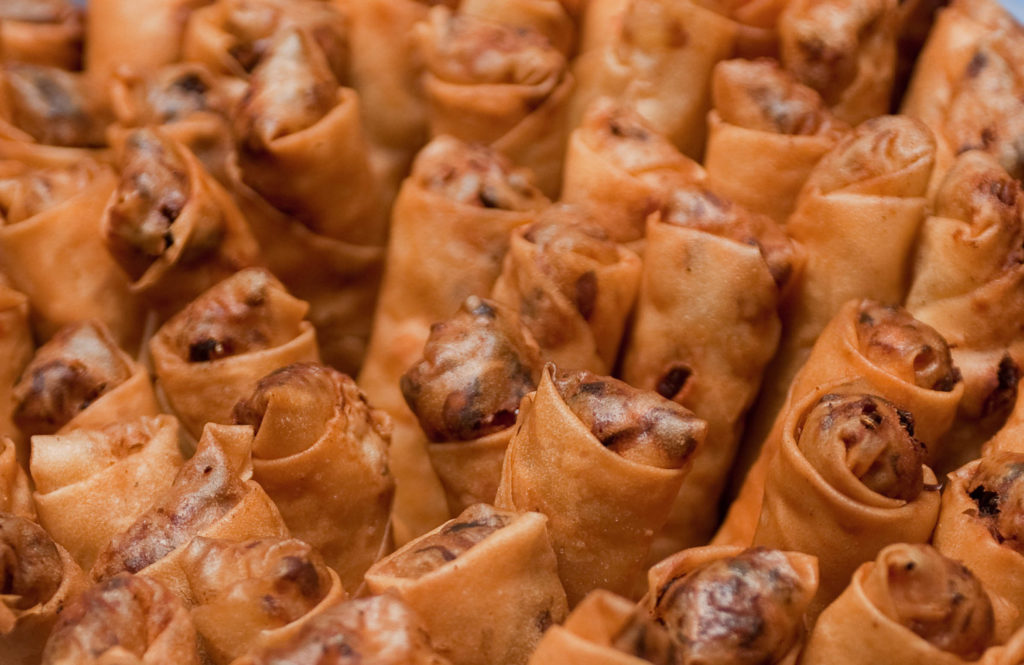Lumpia: Filipino Eggrolls

Description
Meat and vegetables in an eggroll wrap.
History
Origin
On Guam, lumpia is a popular appetizer that is a variation of the Chinese eggroll. It is a finger food that was most likely introduced to Guam by Filipino migrant worker
The introduction of Filipino cuisine to the island may have begun as early as the 17th century when Filipino soldiers were brought to Guam as members of the Spanish military during Christianization and colonization efforts and to also work under the direction of the Spanish administration. By the 19th century, according to the official Spanish census, Filipinos made up 40 percent of the island’s population. Additionally, the post World War II rebuilding of the island provided the employment opportunities for tens of thousands of Filipino workers, both men and women, to the island.
As the Filipino population increased and interaction among ethnic groups took place, the exchange of customs, traditions as well as foods transpired. Today, dishes popular in the Philippines are frequently found on a fiesta table.
Evolution
From China came the eggroll and from the Philippines came the adaptation of the roll called lumpia. There are different versions of lumpia that were introduced to Guam from the Philippines. There is Shanghai lumpia that consists of meat and is eaten with a sweet dipping sauce; banana lumpia, called turon in a Filipino dialect; and, the most common lumpia found on CHamoru fiesta tables which is the variety with a meat and vegetable filling.
Additionally, the Vietnamese version of lumpia has emerged on some fiesta tables as a matter of convenience. It is simply referred to locally in English as “Vietnamese fried lumpia.” After the Vietnam conflict, 100,000 Vietnamese refugees transited through Guam. The island was used as a staging area in the mid 1970s to bring these friends of the US into the country. Some stayed on Guam, however, and made the island their home. In the last few decades their cuisine (as more restaurants specializing in Vietnamese cuisine have opened) has made its way to the approval of local palates.
The Vietnamese version of lumpia is larger and is traditionally eaten with a wrap of romaine lettuce, bean sprouts, rice noodles and dipped in a salty fish sauce.
Preparation
Lumpia consists of a thin rice or wheat flour wrapper filled with a mixture of meat (most often ground pork or ground beef), cabbage, carrots, onions, and garlic. An egg wash is used to seal the lumpia wrapper to ensure none of the filling escapes when it is deep fried. A sweet and sour sauce or vinegar-based fina’denne‘ may be used as a dipping sauce.
As more spices have become available in local grocery stores and made their way into island kitchens, some local chefs have also taken to adding different ingredients to recipes such as oyster sauce as a quick and flavorful ingredient, and as a substitute for salt.
Placement on the table
Lumpia is found among the appetizers on the table adjacent to the kelaguen section, which is after the starch åggon and meat totche selections that are at the head of the table, respectively.
Recipe
Lumpia: Filipino Eggrolls
- 1 pound ground pork
- ½ cup yellow onion (chopped)
- 2 cloves garlic (minced)
- 1 cup cabbage (chopped)
- ½ cup carrots (chopped)
- 1 teaspoon soy sauce
- Salt and pepper to taste
- 1 package lumpia wrappers
- 1 egg
- Vegetable oil for deep frying
Sauté onions and garlic and add pork once the onions are translucent. Add cabbage and carrots and simmer until cooked through. Add soy sauce, salt and pepper. After the mixture has cooled, spoon approximately 2 tablespoons of the cooked meat and vegetables into the center of a lumpia wrapper. Fold the bottom, then sides of the lumpia wrapper and roll to resemble an egg roll. Beat the egg and use a small amount to seal the remaining end. Deep fry the lumpia until golden brown.